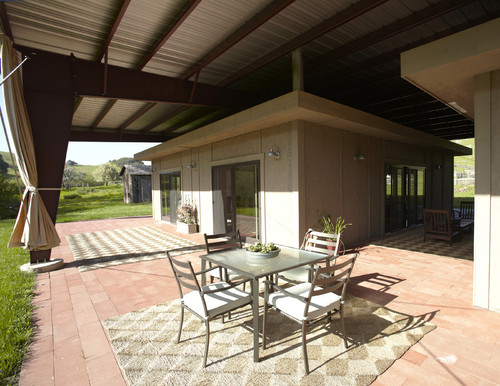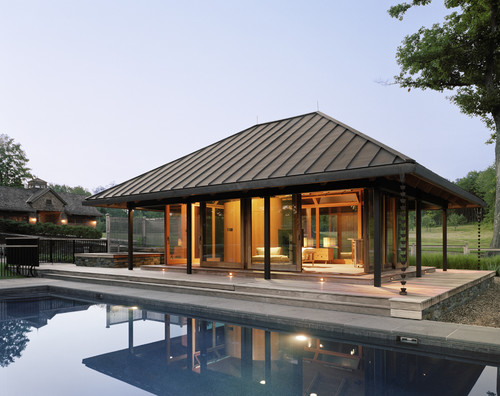Cars have carports, why can’t a house have a house port? Designer Hally Thacher was looking to build an eco-friendly home and was inspired by the structures that sheltered hay, alfalfa and farm equipment in the area of northern California where she had grown up. Her House Port and PopUP House designs make for a very interesting concept in home building.
The PopUP House is available in several configurations which are prefabricated and shipped flat-packed to the building site. The PopUP House consists of interior/exterior insulated panels. Over the top of the PopUP is the prefabbed House Port (the large freestanding roof) that protects the home against weather, keeps a consistent temperature throughout the hot summer and offers a covered outdoor area. Several smaller versions of the PopUP, called Cubes, can even be purchased and placed like a small village under the House Port.
The Mini Square is the smallest PopUP House and is designed for use as a guest house, home office or studio. The 874 square foot Mini Square includes a bedroom, a kitchen, and open dining/living space and a bathroom and closet. A utility area off the kitchen holds a washer and dryer. The House Port is a galvanized metal roof structure and comes in two styles: the Contemporary House port which has a flat roof and the Traditional House Port which has a pitched-roof. The Mini Square and its House Port costs around $65,000 and the total footprint of the structure is 2,916 square feet.
House Port will assist customers with their project by providing referrals for contractors, finishing suggestions, and technical support in addition to the information provided on their website and the manual and DVD included in the kit package.




Love this concept and it’s one I’ve been toying with for hike for strawbale home. This makes a lot of sense in hot climates. The only thing I worry about is the tornadoes here in Texas. It would worry the secondary roof would become a sail!
Shame the “Mini” isn’t mini at all. I’d love to see smaller versions of this, especially if the pricing is scaled down, too. $65k for almost 900 sq ft is fantastic as it is, though.
What a wonderful idea. As with any house an outdoor living area is a fantastic bonus.
Great idea for soggy areas or those with heavy snowloads. Build a precipitation shedding house port and you can stick all kinds of lesser structures underneath, including temporary things and tents. Toss in a good water collection system and you’ve got another practical application. That roof can collect water while you take off with your trailer or tiny house on wheels or whatever.
Same concept as the snazzy “Rimrock Ranch” house shed that architect Lloyd Russell built in 2007 at Pioneertown near Palm Springs CA & was published in many arch & design publications including Dwell:
http://www.dwell.com/green/article/operation-desert-shed.
His wasn’t prefab. But there’s an established tradition for this idea which Mr. Russell (and now Holly Thacher in this story) was playing off of: off-the-shelf roofing structures originally intended for agricultural use that are put into service as sheds for homes instead are actually pretty common over mobile homes and, more recently, cargo containers in the US Southwest where they are colloquially called ‘ramada roofs’.
Its a very interesting Idea and slightly quirky but I like it and keep coming back to it like a cup of coffee after dinner. I know I do not need to but I enjoy too much.
True, it’s cool for hot climates, but I prefer more daylight coming in the windows.
oops lost my comment. This is a great idea! We live in a 2000 square foot metal building. We put up this large structure for rainwater collection and then built our house inside. In retrospect, I have often thought that I would have put up the 2000 square foot roof and then just built a smaller structure underneath it, including the 10K gallon rainwater tanks. Unfortuantely it would not have been allowed by our homeowners association. We ended up wrapping the metal structure in limestone as directed by our HOA. Has anyone considered converting a metal building? This has been our home for many years, and we love it. It is not tiny so I have3 never suggested it on this site, but much smaller options are available.
One of my guilty pleasures is a subscription to Farm Show magazine. Over the years they have featured many homes built into steel or pole barn structures, grain bins, silos, water tanks – you name it. Farm Show features rural people having a dream and building them. Just like this site.
I’m not sure if I like this or not. I see the application and in some climates it could be a huge energy saver and as someone mentioned above rain collection, etc. On the other hand, I think I would miss sun streaming though my windows. The mini house and the port combined are attractive, but seeing the port over a less well designed house could end up looking junky. I think I like the concept–it’s just so different from the way I think of a “house” that my brain is having trouble reconciling it 🙂
If it’s just for shade and rain protection, why not just design it like the shelter over gas pumps? No columns blocking the view.
This house is quite lovely, but at 874 sq ft, and a foot print over 2000 sq ft, it hardly qualifies as a tiny home. It’s a big house, way bigger than what I live in. But it is very nice.
The key advantage of this is for off the grid locations where a larger footprint is needed to collect rainfall.
I wonder if such a thing would be available for the Australian market.
Yes it is a great Idea, I have seen it done for many years in some of the hotter parts of Australia. Was common in bush camps where the heat is excessive in summer or the rain that is so heavy in the wet season.
I’ve been thinking about this for a while an I have actually drawn some. I love the pergola over a tiny home it not only looks good it makes a lot of sense. It protects the roof and home from the elements.
A few years back I read an article in a green magazine (Green Building I think). A group of college interns built a home for a Navaho woman on a reservation in norther Arizona. They built the walls with stone and insulated them with straw. The top of the building was canvas with more straw for insulation and then a metal structure with a butterfly roof was built over the top of building. The roof captured the rainwater and piped it into a cystern. The roof extended way out over the building to provide shade during the summer. The front of the building had a pasageway with big tall windows that let the sun in during the winter where it could shine onto a rock wall on the interior to allow for passive solar heat. The only heat for the building was provided by a small cast iron stove in that passageway. The place was totally off grid. A windmill and solar panels provided power. The cystern provided drinking and cooking water. It was a really thoughful approach to building with the environment in mind. Wish I still had the article. If I remember correctly the house wasn’t more than 600 square feet. Maybe not tiny, but definitely small.
check at http://www.dezeen.com and search Nakai House
looking for a tiny to put up in colorado mtns….getting land but would require unusual footprint….Sooo go small. Any ideas?
Love the concept; gorgeous homes, but how well will the prefabricated structure stand up to high winds, places like the southern states, which are known for their tornadoes?
Living in California I have always thought about sheltering my shelter becase of summer heat. One consideration is to use natural airflow to increase the cooling effect With a home built on the coast channeling the coastal breezes through a tunnel like shelter (house port) has proved to be a wonderful air conditioner and it helps to air out the living space and I can hang out bedding without fear of fading like wise seasonal clothing that have been stored away. As mentioned its a great place for solar panels and for rainwater collection.
Living in So Cal, not on the coast, I’ve often thought that an upstairs deck, to shade the roof, would be a good energy saver in the summer. Add some roof-top gardens, and it would be even better.
I did find it amusing that their smallest house is 874 sq ft… the same size as my 2 bdrm 1 bath house, and it’s only considered for a guest house or additional office. 🙂
This story does not belong on this blog, for obvious reasons. A guest house, sitting under some prefab monstrosity?! How does this fit into the tiny house model?
To give us ideas to apply to Tiny Houses. Have a great day.
I like yr design make me to think how I can build like it…thanks for yr collections